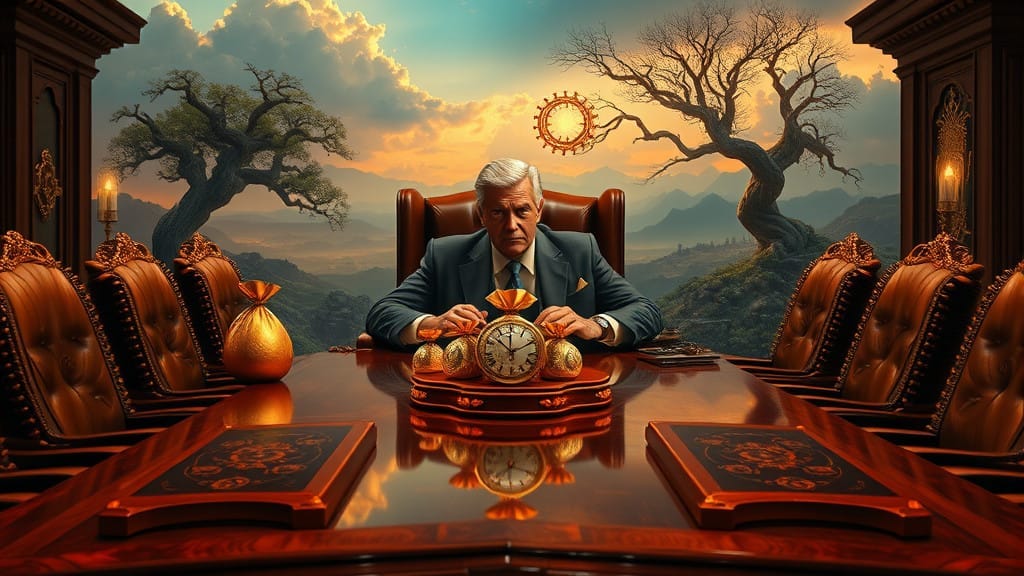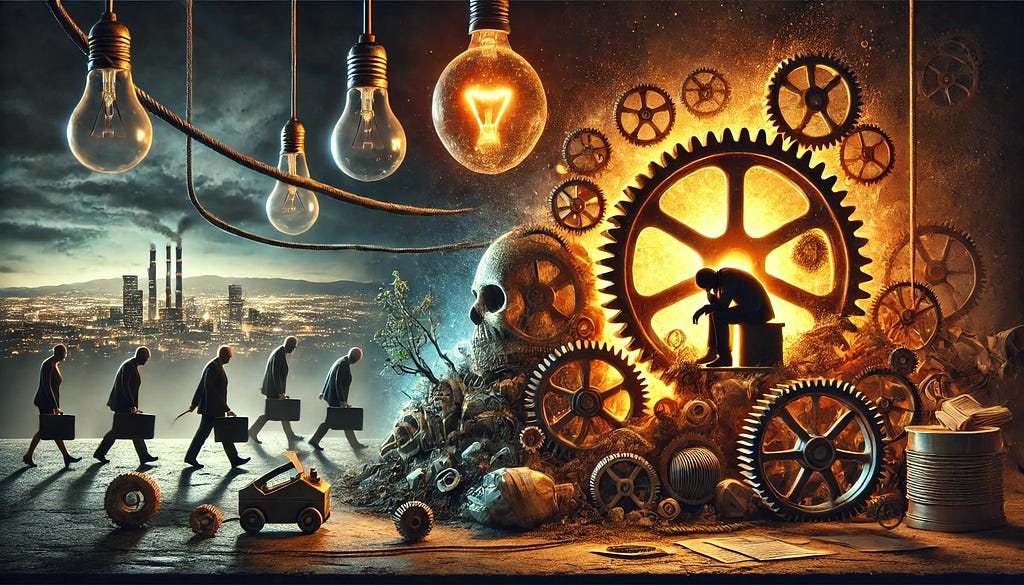“If you’re running from a mountain lion, it’s not a good idea to expend energy on growth. In order to survive — that is, escape the lion — you summon all your energy for your fight-or-flight response. Redistributing energy reserves to fuel the protection response inevitably results in a curtailment of growth.” — Bruce Lipton
In both the human body and a corporate body, stress responses serve as critical mechanisms for survival and adaptation. When stressors emerge, whether in an organism or an organisation, the immediate focus often shifts to short-term goals at the expense of long-term growth.
If an organisation waits until it’s in the midst of a crisis to start preparing for the future, it is already too late. If we wait until a crisis, our decision making is flawed and we are less tolerant of the failures that are symbiotic with Innovation.
The Stress Response: Short-Term Focus

When the human body faces a stressor — be it a physical threat, illness, or psychological strain — it prioritises survival. Energy is rapidly mobilised, heart rate increases, and digestion is put on hold. The body’s entire focus shifts to the immediate present, diverting resources from long-term processes like growth, repair, and immune function.
Similarly, when an organisation experiences stress — whether from economic pressures, competitive threats, or immediate needs such as sustainability goals — it focuses on short-term survival. Resources are often redirected from innovation, research, and long-term strategy to immediate crisis management. Just as in the human body, this short-term response can be effective in small doses. But when an organisation remains stuck in this reactive mode, it risks neglecting the very processes that sustain long-term success.
Temporal Discounting and Leadership Compensation

“One factor that makes behaviour change difficult is the power of now. Simply put, goals that are near in time get more arousal than goals that are distant in time. The more active the goal, the bigger the influence it has on behaviour. Consequently, you are biased against doing things that will pay off in the long run when there is some other activity you could do now to achieve a short-term goal. This competition between short-term and long-term goals is one key source of systematic goal failure. To put your long-term goals on an equal footing with your short-term goals, you need to recast the activities that will pay off for you in the long run in terms of specific goals you can achieve on a daily basis that will ultimately lead to long-term success.” — Art Markman , Smart Change
One of the key drivers of a short-term focus is temporal discounting, a cognitive bias where immediate rewards are valued more highly than future ones. Under stress, both the human body and corporate leadership tend to favour short-term actions over long-term strategies. This is especially true when leadership compensation is tied to short-term financial performance, such as quarterly earnings or stock prices.
In the heat of a crisis, much like the body prioritises immediate energy for muscles, leaders often prioritise actions that boost short-term metrics at the expense of long-term growth. When a confronted with stagnant growth, declining margins, or falling market share, most executives pick up the knife and begin the brutal work of restructuring. The goal is to carve away layers of corporate fat, jettison underperforming businesses, and raise asset productivity.
The need to satisfy investors, meet earnings targets, and keep stakeholders happy, but leaves little room for the long-term activities required to truly fix the ‘roof.’
As JFK’s quote implies, the most strategic time to build resilience and focus on growth is not when the organisation is in crisis but during periods of calm.
As Stan Deetz told us on a recent episode of The Innovation Show, “People are natural learners. They don’t learn well when they’re scared because they pull in and protect themselves. Organisations are natural learners, but they don’t learn well when they’re scared.”
The Long-Term Cost of Chronic Stress

Prolonged stress in the human body leads to allostatic load — the cumulative wear and tear from constantly being in a heightened state of alert. Chronic activation of the stress-response system weakens the immune system, increases the risk of heart disease, and leads to long-term cognitive decline.
In organisations, chronic short-termism can create a similar form of exhaustion. Just as the body eventually wears down under sustained stress, so too do companies that continually focus on short-term gains. Innovation, employee morale, and long-term sustainability suffer, leaving the company vulnerable to larger, systemic crises in the future.
Short-term fixes — like cost-cutting, workforce reductions, or quick profit boosts — may temporarily relieve stress, but they do so at the cost of long-term health. Without a forward-looking strategy, the corporate body weakens, becoming less adaptable and more prone to failure.
Stress and Cognitive Shifts in Leadership: Cutting the buck is easier than expanding the bang

“When emotions are high, our cognitive abilities drop, right? So our ability to think clearly, our ability to problem solve, our ability to strategize, our ability to emotionally regulate. So as emotion goes high, it’s very common that cognitive abilities will diminish in those moments.” — Dr. Julia DiGangi on our latest episode of The Innovation Show
Under chronic stress, human cognition shifts. Decision-making becomes more reactive, memory is impaired, and the ability to focus on the long term is diminished. In organisations, leaders facing continuous crises tend to make short-sighted decisions, focusing on immediate returns rather than investing in future growth. This mindset is compounded by leadership structures that reward short-term performance, reinforcing a cycle of short-termism that is difficult to break.
Much like how a body under chronic stress sacrifices long-term health to manage the immediate crisis, leadership focused on short-term success may sacrifice innovation, strategic growth, and even employee wellbeing. The corporate body, like the human body, needs periods of recovery to thrive in the long term.
What this also suggests is that while resource cutting is not an essentially creative activity, resource leverage is. It is about the continual search for new, less resource-intensive means of achieving strategic objectives. Slimming down the workforce and cutting back on investment are less intellectually demanding for top management than discovering ways to grow output on a static or only slowly growing resource base. As Gary Hamel tells us on our forthcoming series on The Innovation Show, “Cutting the buck is easier than expanding the bang”. Managers and operational improvement consultants must ask themselves just how much of the efficiency problem they’re actually working on. If their view of “efficiency” encompasses only the denominator, if they don’t have a view of resource leverage that addresses the numerator, they have no better than half a chance of achieving and sustaining world-class efficiency.
Balancing the Present with the Future

“The world is sensory rich and causal poor”. — Daniel Freedman
Both organisms and organisations require a balance between short-term crisis management and long-term growth. The human body cannot survive without responding to immediate threats, but it also cannot sustain itself if it neglects long-term processes like healing, growth, and reproduction. Similarly, organisations must balance the need to address immediate challenges with the need to invest in their future.
Organisations that succeed in the long run are those that understand when to repair the roof. They recognise that short-term crises will come and go, but long-term growth requires continual investment, even in times of calm. Leaders must resist the temptation to focus solely on the present and instead create a culture that values long-term sustainability.
The corporate body, much like the human body, must navigate stress with a balance of short-term reactivity and long-term vision. Leadership plays a crucial role in managing this balance, ensuring that organisations don’t fall into the trap of perpetual short-termism. As JFK wisely noted, “The time to repair the roof is when the sun is shining.” Leaders must seize these moments of stability to invest in the future, ensuring their organisations remain resilient in the face of inevitable stressors
As we enter into a new year, we must heed this advice ourselves, we must not neglect our own health until a crisis hits. It is harder to exercise under duress than it is to do when you are fit. It is harder to care for yourself when you are unwell than when you are healthy.
Happy New Year!
The series with Dr. Julia DiGangi is available below:
https://medium.com/media/5bf01778603ff2a2e876a920324173a1/hrefhttps://medium.com/media/134f05ad7d87c290c52781877ed9cefe/hrefhttps://medium.com/media/fcb6e15d03aad5f30a4c778face68714/href
Corporate Bodies Under Stress: Balancing Immediate Survival and Long-Term Growth was originally published in The Thursday Thought on Medium, where people are continuing the conversation by highlighting and responding to this story.